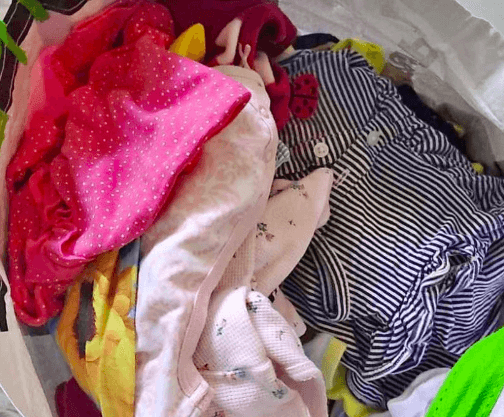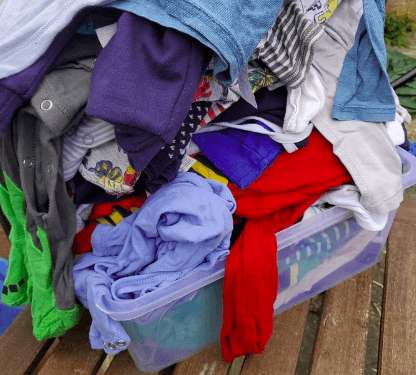Babies and baby clothes are adorable but tend to get dirty quickly. You might have to wash baby clothes frequently as they get stains.
However, you can’t wash baby clothes like you wash adult clothes because babies are extra sensitive to almost everything. They have not built enough immunity to the world, its particles, and chemicals.
Fortunately, these steps will guide you in making the correct decisions when doing your baby’s laundry.
Things to Note Before Washing Baby Clothes

It may surprise you to discover how quickly baby laundry piles up. Anytime you find yourself changing the baby’s diapers or feeding the diaper, you will have to also change the baby’s clothes because of stains.
Arrange the clothes in a baby laundry pile to make things less stressful for you.
Also, you should take precautions when washing baby clothes to avoid the chemicals that can be harsh on their skin.
Step 1: Prep the Baby Clothes
Before you wash any baby clothes, there are basic preparatory procedures to conduct.
Read the Care Label

The care label attached to baby clothes contains vital information about the care and washing instructions unique to each cloth.
These instructions tell you how to wash the clothes, what medium to wash them in, what temperature is conducive for the clothes care, etc.
Baby clothes come in various fabrics, and these fabrics guide the care label instructions. The method of washing cotton baby clothes will be different from the method of washing silk or polyester.
Another piece of information the care label gives is whether you can machine wash or hand wash the baby clothes or if they are dry clean only.
The care label also provides drying and ironing instructions and lets you know if the baby clothes are flame-retardant so you can adjust your wash process accordingly.
Sort the Baby Clothes
Like regular clothes, you should separate baby clothes according to their color. Keep white baby clothes separate from colored ones and lightly colored clothes from dark-colored ones. This separation will prevent color transfer and design damage on the baby’s clothes.
Even after separating the clothes by color, go a step further and separate them according to their fabric types. Various fabric types have different wash processes and settings and cannot be in the same load.
Also, keep flame retardant clothes away from regular baby clothes to avoid damaging the flame retardant properties of the clothes.
Step 2: Pre-Wash the Baby Clothes
After sorting the baby clothes into separate groups, you will start the washing process.
First Wash
When you get baby clothes for the first time, whether they are brand new or hand-me-downs, you should wash them before putting them on your baby.
The journey the baby clothes went on to get to your location must be rife with chemicals and surface particles, which can affect your baby’s skin and overall health in severe cases.
Remove Stains from the Baby Clothes
When you have a baby, you will spend so much time removing dirt and stains from them and their clothes. There are many methods of removing stains from baby clothes, but there is a basic procedure.
Procedure:
- First, remove the excess stains from the clothes with a paper towel or a soft towel. Most times, this step is enough to remove the stains.
- Lay the stained baby clothes on a flat surface.
- Pour a suitable baby-safe stain remover on the stains and leave the treatment to soak for 10 minutes.
- Gently dab the stains and rinse with cold water.
- Then, you will wash the clothes.
Soak the Baby Clothes
Soaking the baby clothes is a step further from spot treating carried out when there is a need to deep clean the clothes or the stains are tough.
Procedure:
- First, remove the excess stains from the clothes with a paper towel or a soft towel.
- Fill a sizable bowl or bucket with the correct water temperature – refer to the care label – but you can use cold water to be safe.
- Pour a tiny amount of baby-safe detergent into the water and swish with your hands till it foams.
- Submerge the baby clothes into the soapy water and let them soak for 20 to 30 minutes.
- Afterward, rinse the clothes and transfer them to the washer.
Step 3: Wash the Baby Clothes

When you get to this step, you are already well on your way to having a perfect wash cycle, but there are some things to note. After the wash cycle ends, run an extra rinse cycle to remove any residue that might linger on the baby clothes.
The Laundry Load
As stated previously, dirty baby clothes can pile up into large stacks in a short period. After sorting the clothes, the batches will be smaller, making the laundry load better suited for the washer.
Before putting the baby clothes in the washer, especially new ones, check for tags and take them out to prevent snags and tears. Turning the clothes inside out can also prevent damage by hiding the buttons and zippers; it will also preserve the color and design of the clothes.
Place smaller items like socks or delicate fabrics inside mesh bags before putting them in the washer.
Do not place the baby clothes in the same load as adult clothes to prevent contamination. Also, separate baby clothes from reusable cloth nappies because although their wash processes are near identical, there can still be cross-contamination.
Choose the Correct Detergent
Your choice of detergent is arguably the most vital decision you have to make when washing your baby’s clothes.
Detergents have harsh chemicals that can irritate your baby’s skin or cause them to fall sick. You should get a non-biological detergent free of enzymes. The detergent should be hypoallergenic, free of fragrance, dyes, fabric softeners, etc.
There are many detergents in the market, and searching for these properties can get tiring, so start with specialized baby detergents or detergents made for sensitive skin.
When you have the correct detergent, you should read the instruction label to know the amount of detergent you can use. Excess detergent in the wash will leave residue on the baby clothes, which will irritate the skin.
Use the baby detergent on other clothing items the baby contacts.
Choose the Correct Wash Settings
The care label instructions will inform the wash settings you select for washing the baby clothes.
Match the correct wash cycle and water temperature to the baby clothes to avoid damaging the clothes.
Most baby clothes can handle hot water temperature for the wash cycle, but this will not be necessary with some detergents powerful enough to clean the clothes with cold water.
How to Hand Wash Baby Clothes
Some people recommend hand washing baby clothes instead of putting them in the washer to control the wash process better.
Hand Washing baby clothes follow the same procedure as machine washing, including the sorting, water temperature, and detergent choice.
Procedure:
- Follow the instructions in steps one and two, and step three, excluding the wash settings.
- Select a bowl, bucket, sink, or bathtub that will be your washing medium.
- Wash your hands and the preferred washing medium before washing the baby clothes.
- Fill the bowl or bucket with water and pour in a baby-safe laundry detergent.
- Submerge the clothes in the water and let them soak for ten minutes.
- Gently wash the clothes and rinse them.
- Soak the clothes in clean water again for ten minutes.
- Dry the clothes.
Step Four: Dry the Baby Clothes
Dry the baby clothes immediately after washing them to prevent color bleeding and residue build-up.
Use low heat to dry your baby’s clothes because too much heat can cause damage. Do not use dryer sheets with the clothes because the chemicals can irritate the baby’s skin. However, wool dryer balls are suitable for speeding up drying time and reducing static.
If you must air-dry, try to avoid direct sunlight and use a well-ventilated area to avoid residue build-up on the wet clothes.
